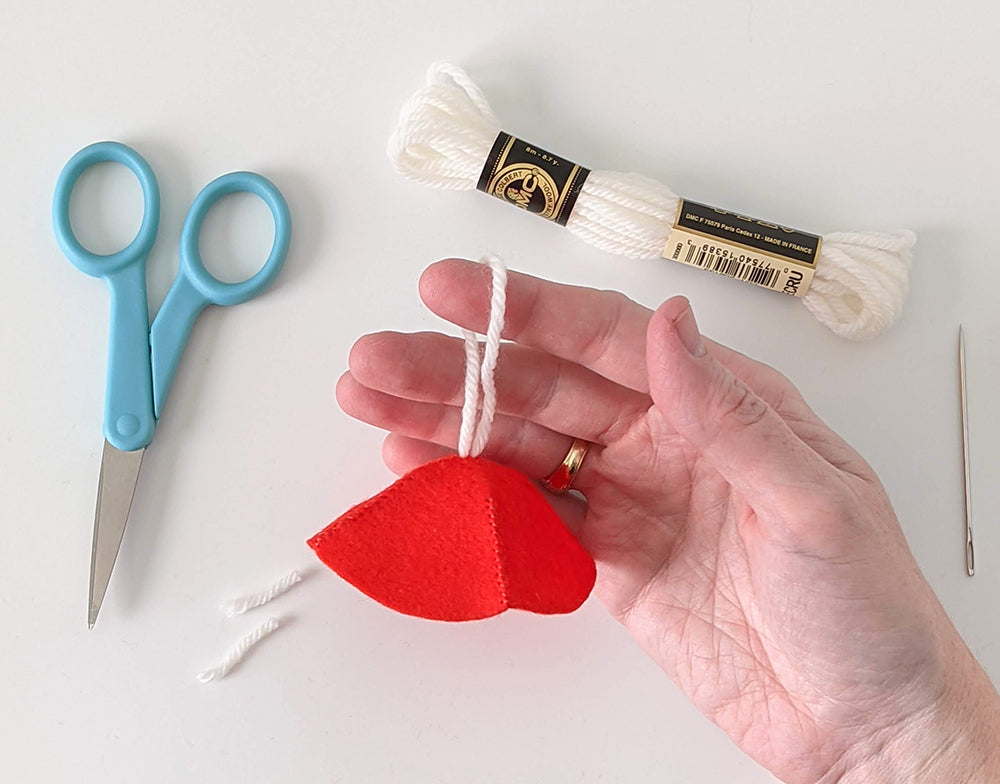Share

Mushrooms are everywhere! Have you noticed? Benzie team member Camille of @notsomodernmillie decided to try her hand at making her own and she's sharing the steps and tips in this tutorial. It's a project you simply mush try!
I adore mushrooms. More accurately, I adore the charming bright fairytale mushrooms that aren't growing in my yard. So I went looking for the perfect mushroom pattern and couldn't find it. They were either too fussy or too simple - a real Goldilocks story. So I made my own porridge, I mean pattern, and I am so pleased to share it with you! In a reasonable amount of time with simple supplies, you'll be able to make a whimsical mushroom ornament that's *just right.*
Skill Level: Beginner
Time: 1 hour
Additional Supplies:
Felt Mushroom Pattern (click to download)
Hole Punch
Pencil
Directions:
1. Print the Felt Mushroom Pattern (using the SVG or PDF above) onto cardstock. Cut out pattern pieces. The dotted lines on the Mushroom Cap are suggested cutting lines. To give the mushroom a taller dome (and smaller circumference) make the triangles wider. To give the mushroom a flatter dome (and larger circumference) make the triangles narrower.
If you prefer to cut the mushroom pieces with a cutting machine, a link for the SVG file is in the supply list above.
2. Trace pattern pieces onto corresponding felt colors and cut out as follows:
Cap - One from Carmine felt or color of choice
Base - One from Ecru felt
Skirt - One from Ecru felt with optional scallop cut along dotted line
Stem - One 6 x 2-1/2" rectangle from Seaside felt (no pattern piece)

3. Begin by stitching the mushroom cap. Use the Carmine embroidery thread (or coordinating thread color for your mushroom) and stitch the sides of each triangle closed with a simple whip stitch. Stitching the triangles closed will give your mushroom it's dome shape.

4. Thread a 10" length of Ecru tapestry wool through your darner needle. Come from the inside of your mushroom cap and out through the center of the dome. Put the needle back in very close to the first exit point. Remove the needle and adjust the tapestry wool to make a loop at the top of the mushroom. Tie the tapestry wool in a knot underneath the cap and trim any excess.


5. Place your mushroom cap on the center of your mushroom base. Because the cap circumference is now smaller, you will need to trim the base. The pattern does not include a modified base in case you decide to make your mushrooms more or less domed.

6. Whip stitch your mushroom cap to the base using the Ecru embroidery thread.

7. Stuff the mushroom cap with Polyfil. Use your finger to insert the stuffing through the hole in the base. It is okay if the hole stretches out as you work - that will be accounted for in the next step.

8. Put a line of glue along one short side of the Seaside felt rectangle. Tightly roll the rectangle to form a mushroom stem. Be sure to keep one end neat and even.

As you roll, compare the size of the stem to the opening in the mushroom base. This is where your stem will be inserted. When the stem diameter is about the same size, trim away the excess felt and glue the end of the rectangle closed.

9. The felt piece for the mushroom skirt is longer than needed to allow for varying stem sizes. Put a thin line of glue about 1/2" from the (uneven) end of the stem. Beginning at the stem seam, attach your mushroom skirt to the line of glue. Work around the stem until you reach the beginning of the skirt. You can overlap the skirt ends slightly or trim them to meet exactly. Trim excess felt and glue the ends together.

10. Wiggle your finger in the opening of the mushroom base to make a hole in the stuffing. Put glue on the top part of the stem and skirt and insert them into the hole.


11. Use a hole punch to punch out circles from the Ecru felt scraps. Glue the felt dots onto the mushroom cap in your desired pattern.

Your mushroom ornament is finished! Use it as a present topper or place setting or make dozens of them to adorn your Christmas tree.

You'll have so much fun making these, it'll be hard to stop... or so I've heard.

Thanks to Camille for designing and writing this tutorial! You can follow her on Instagram @notsomodernmillie or visit her website. Stay tuned for more tutorials!